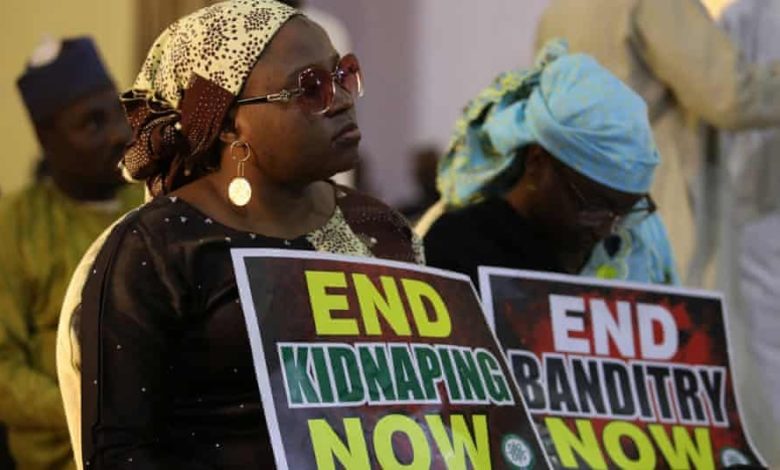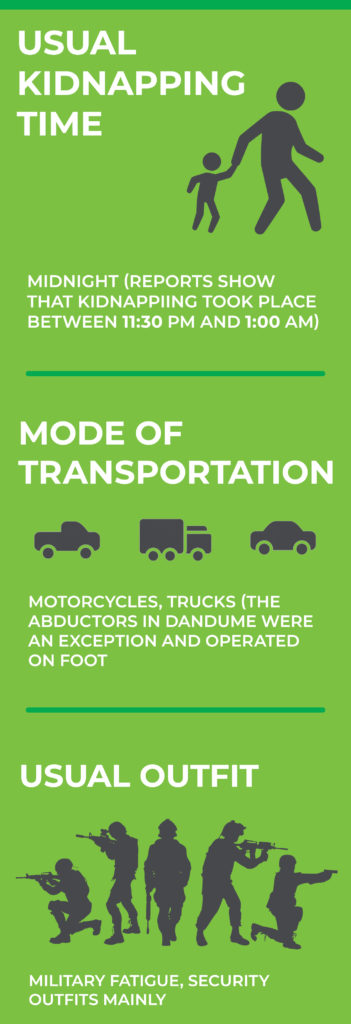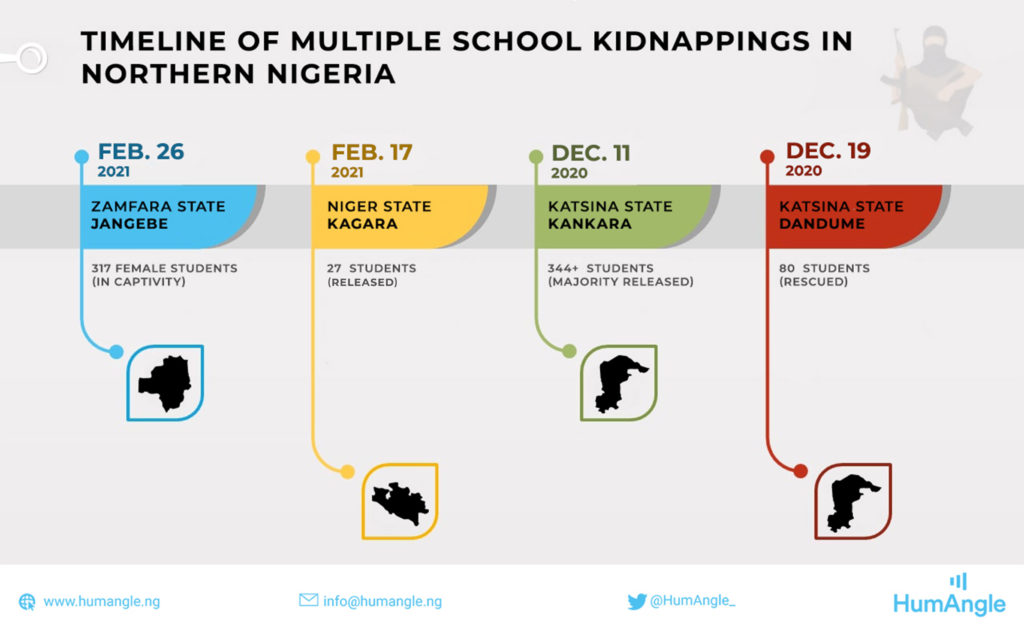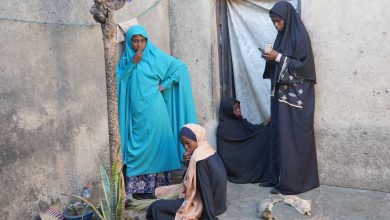Timeline: Multiple School Children Kidnappings In Northern Nigeria Since December
In the last three months, there have been repeated kidnappings in Northern Nigeria. It is hard to tell them apart, but this timeline should help you.

Feb. 26, Zamfara State
On Friday morning, news broke about the kidnapping of over 317 schoolgirls in Zamfara, Northwest Nigeria. This came just a week after a similar kidnapping incident.
The abductions, suspected to be carried out by terrorists (popularly referred to as bandits in the region), have several similarities that make them easy to mix up.
In the most recent abduction, carried out on Feb. 26, “unknown gunmen … took the girls away” in a midnight raid on the Jangebe Government Girls’ Secondary School, according to Sulaiman Tanau Anka, information commissioner for Zamfara State.
The attack reportedly happened at 1 a.m. when a group of gunmen arrived at the school with pick-up vehicles and motorcycles.
According to some sources, some of the gunmen were dressed as government security forces, and they forced the schoolgirls into the vehicles.
Feb. 17, Niger State
On Feb. 17, a similar overnight operation took place, leading to a student’s death and the kidnapping of 42 people, including 27 students. The hostages were released on Feb. 27, ten days after their abduction.
The attack took place in Kagara, Niger State, Northwest Nigeria.
According to witnesses, the gunmen, wearing military fatigues, stormed the Government Science Secondary School Kagara around 2 a.m.
“Information reaching us is that 27 students are still missing. We don’t know the number of teachers at the moment. We don’t want to put numbers that will turn out contradictory, but efforts are being made to rescue them,” Mary Noel Barje, the chief press secretary to Governor Abubakar Sani Bello, said.
Some Kagara community members have confirmed that they had received warnings about the planned attack and were on alert. They were, however, at a loss because they did not know where the exact attacks would take place.
Governor Abubakar Sani Bello of Niger State has accused the Federal Government of abandoning the state to its fate to rescue the abducted students and staff.
The governor, who expressed frustration when Chief Whip of the Senate, Orji Uzor Kalu paid him a sympathy visit at Government House, Minna, on Thursday, said although the federal government sent a delegation in the wake of the kidnap, the state government had been left to shoulder the financial responsibility alone.
He said, “The Federal Government has sent a delegation to the state and deployed additional 300 mobile policemen, but the government has been left to shoulder all the financial responsibility, so where is the support?”
“At the moment, we have not seen any federal support here since this incident occurred. Yes, we had a delegation that came to commiserate with us, but we are left to our fate,” he added.
The governor, however, gave the assurance that with or without the support of the Federal Government, the state government had already taken steps to rescue unhurt the abducted students, staff and their relatives in captivity.
Upon the release of the students, however, the state government did not make any comment on how they secured their release.

Dec. 19, Katsina State – Dandume foiled kidnapping attack
Less than two days after the kidnapped Kankara students’ release, on Dec. 19, some gunmen abducted more than 80 Islamic school students in the same Katsina State.
This time, the pupils were quickly rescued by security forces after a fierce gun battle, according to the police.
The attempted kidnapping took place in Dandume, about 64 kilometres from Kankara, the town where the earlier kidnapping of schoolboys occurred.
The terrorists had already abducted four people and stolen a dozen cows when they ran into the schoolchildren who were on their way home from a celebration, said Katsina state police spokesman Gambo Isa.
The Police and a local community self-defence group rescued the children from the bandits after a gunfight, he added.
“The teams succeeded in dislodging the bandits (terrorists) and rescued all the 84 kidnapped victims and recovered all the 12 rustled cows,” Isa said in a statement.
Dandume, an area bordering the northern part of Kaduna state, is one of the region’s hotspots for banditry and kidnapping, according to residents.
Dec. 11, Katsina State – Kankara boys kidnapping and its drama
In the second week of Dec. 2020, HumAngle broke the news of the attack on Government Science Secondary School students, Kankara, Katsina State, and students’ abduction by a group of armed men on motorcycles.
To date, the actual number of students kidnapped on Dec. 11 is still being debated.
Aminu Masari, Governor of Katsina State, said 333 students were missing when he received the Federal Government delegation led by Monguno.
“Based on the available records, we are still searching for 333 students through either the forest or their parents to ascertain the actual number that has been kidnapped,” The Cable quoted Masari as saying.
“We are still counting because more are coming out from the forest, and we are calling those parents that have phone numbers to find out whether or not their children have gone back home. As a government, we are yet to be contacted by any group or person responsible for the kidnap of the students.”
The military deployed ground and air troops in search of the children while the Katsina State Government ordered the closure of all schools following the incident.
Meanwhile, after Boko Haram claimed responsibility, the group disclosed that it had 523 children in captivity.
A source within the group confirmed this to HumAngle. There have been at least five conflicting figures in the press.
Soon after the abduction took place, several media reports had estimated that about 600 pupils of Government Science Secondary School, Kankara, were missing as some gradually emerged from the surrounding forest in the morning.
Boko Haram released a video showing the boys several hours before they regained freedom. Although the Nigerian government has dismissed it, the video indicates that the terror group was involved.
“Even if I didn’t say anything, here are my people speaking and here are your boys speaking too,” said Boko Haram leader Abubakar Shekau, referring to the abductors that appeared with the schoolboys in the proof of life video.
Both the Katsina and Zamfara State Governments have, however, insisted that the terror group, whose stronghold is in the northeast, was not involved in the abduction.
Challenging this narrative, a source within Boko Haram asked rhetorically, “If we are not involved, how come we secured a video of the boys?” The source did not provide further reasons to substantiate the group’s involvement.
HumAngle had also identified the teenage student who spoke in the proof of life video. The boy was among those released and, narrating his ordeal, he said the terrorists persuaded him to talk in the video before being released with 343 other students.
HumAngle had reported that Boko Haram members were steadily stepping up their presence in the Northwest, taking advantage of the surge of criminality and security loopholes. Shekau’s faction of the group is gaining weight and sealing allegiances across northern Nigeria. In July, the faction released a video that confirmed its link with armed groups based in Niger State and operates in the Northwest.
An investigation by HumAngle has revealed that, as of July 2020, Shekau’s faction had over 400 active fighters in the sub-region.
According to the report, this figure does not include those of Ansaru and Islamic State’s West African Province (ISWAP) fighters, who are already established in the area, preparing to wage war on citizens and state operatives.
“I don’t know who they are, but they said I should say they are Boko Haram —a gang of Abu Shekau,” the young boy in the proof of life video had said at the Katsina State Government House, echoing his exact words in the released clip.
On Dec. 17, HumAngle reported that at least four intermediary groups were in talks with Boko Haram sub-faction in northwest Nigeria to get the terror group to release the over 500 secondary school students it abducted.
Later that night, Governor Masari confirmed the abducted boys’ release and said no ransom was paid before the boys were released. “We did not pay ransom to the kidnappers, it was purely negotiation,” he said.
Explaining how the boys were released, he said, “One hour ago, Nigerian soldiers and government officials that were involved in the negotiation for the release of the kidnapped schoolboys told us that the whole school children had been released, 344 of them.
“Those involved in the negotiation include my adviser, some top military and police operatives, members of Miyetti Allah; (they) were all involved in the negotiation.”
He also said those who kidnapped the boys were not Boko Haram: “They are bandits who kidnapped the schoolboys.”
Meanwhile, Nigeria’s defence minister, Bashir Salihi Magashi, set off outrage earlier this month after advising people not to “be cowards” and defend themselves against kidnappers.
Support Our Journalism
There are millions of ordinary people affected by conflict in Africa whose stories are missing in the mainstream media. HumAngle is determined to tell those challenging and under-reported stories, hoping that the people impacted by these conflicts will find the safety and security they deserve.
To ensure that we continue to provide public service coverage, we have a small favour to ask you. We want you to be part of our journalistic endeavour by contributing a token to us.
Your donation will further promote a robust, free, and independent media.
Donate HereStay Closer To The Stories That Matter





